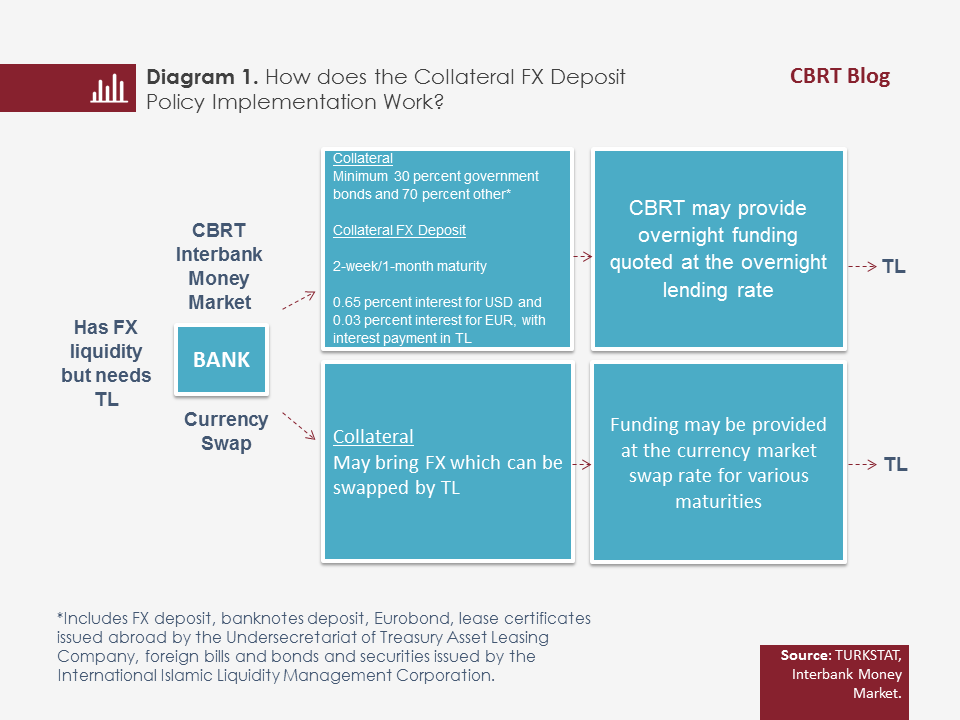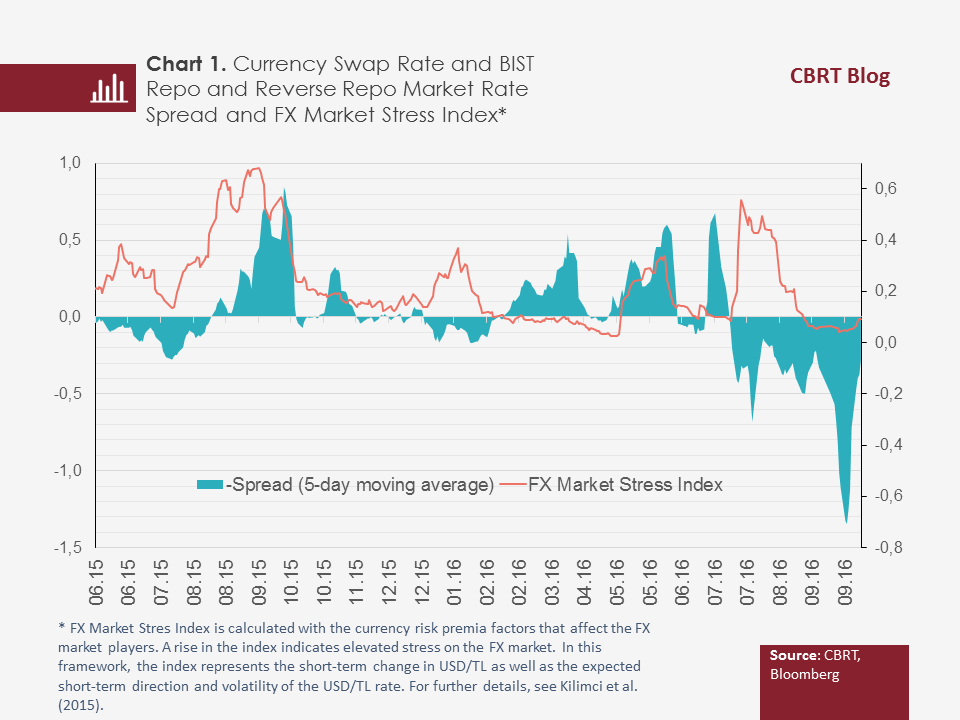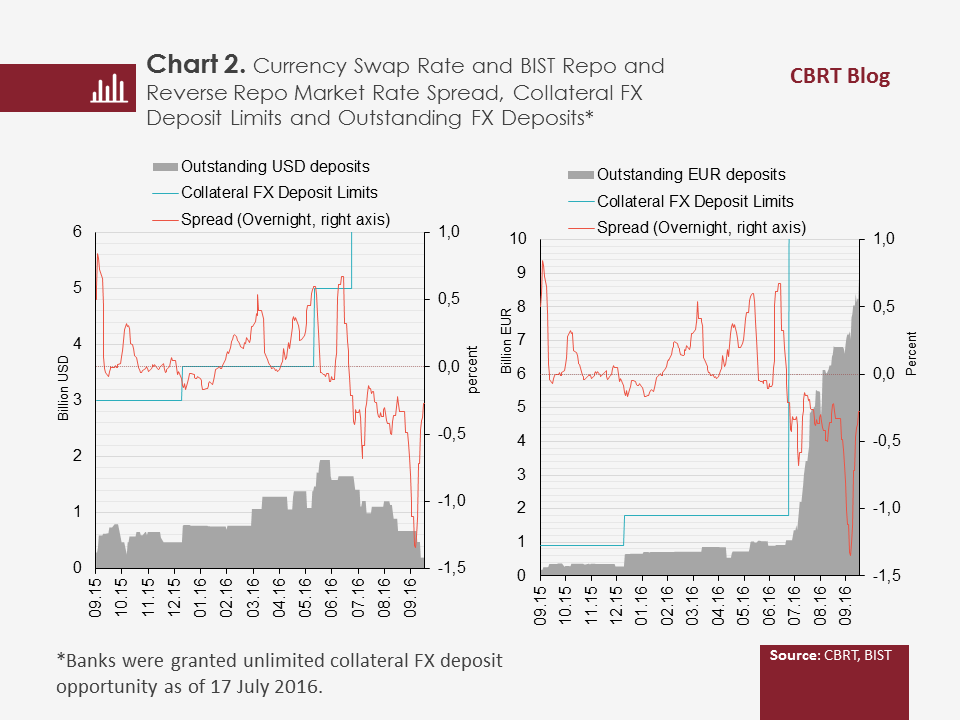Inflation targeting central banks affect short-term market rates in the first step of the monetary transmission mechanism. This provides the effectiveness of the monetary policy through exchange rate and long-term interest rates, which are influential on consumption and savings decisions of economic units. One of the most important benchmarks for short-term market rates in Turkey is the overnight rates (BIST repo rates) at the BIST Interbank Repo and Reverse Repo Market, where only banks can make repo transactions. Besides BIST Interbank Repo and Reverse Repo Market, banks can also use the short-term currency swap market for liquidity management. The currency swap market is an important market where banks can also obtain liquidity especially from foreign investors. The BIST repo rate has a significant role in the pricing of the overnight rate at the currency swap market. Hence, the cost of funds obtained via the currency swap market is expected to be close to the BIST repo rate (Kara, 2015). On the other hand, in periods of heightened volatility in both domestic and global markets, the deteriorated risk perception of market players and increased motive for hedging may cause swap rates to hover above BIST repo rates. Moreover, banks in need of collateral use the currency swap market more effectively for liquidity management, which imposes an upward pressure on TL interest rates and causes inefficiency in the monetary transmission mechanism. Accordingly, various arrangements were made by the CBRT to provide an efficient operation of TL and FX markets and to support banks’ liquidity management. This article provides a discussion of the main motivation for the implementation of the collateral FX deposit facility and presents a graphical analysis of its impact on the currency swap market.

During periods of heightened stress in financial markets, all market players’ taking a simultaneous and similar position may cause undesirable tightness and volatility in financial conditions. In times of an elevated exchange rate risk, the demand for currency increases due to the hedging motive, which leads to a surge in both the level and the volatility in the currency swap market and the spot market. Moreover, in stress periods with shallow liquidity in the FX market, the demand for currency may increase even more, thereby causing a vicious cycle. Meanwhile, during market stress, the co-movement of the currency swap rate and the BIST repo rate may be violated. Chart 1 shows that in times of heightened stress in the FX market, the currency swap rate may deviate from the BIST repo rate. This is because of higher perception for risk, which causes increased demand for currency, and this leads to higher TL sales and FX borrowing with precautionary and speculative motives, which causes higher forward FX rates. Also, investors demand a higher return for TL, which is perceived to be more risky, and this drives currency swap rates above the BIST repo rate. In this context, the collateral FX deposit facility is identified as an important tool in view of its similarities with the currency swap market as well as its support for TL during possible unilateral positioning in the currency swap market (Diagram 1).

In the “Road Map During the Normalization of Global Monetary Policies” announced in August 2015, the collateral conditions for TL transactions at the CBRT were simplified as of 28 September 2015 and the implementation rules for collateral FX deposits were changed. Accordingly, interest revenues accrued by gains in international markets obtained by FX deposits, which were previously transferred to respective banks after deducting costs, are now exempt from expenses while the interest rates are announced on a daily basis depending on the market conditions. Moreover, the maturity of FX deposits were previously set to be no shorter than 1 month in agreement with the relevant bank, while, currently, the maturity of the collateral FX deposit is set as 2-weeks and 1-month. Effective as of 28 September 2015, an upper limit was introduced for collateral FX deposits, which is determined on a bank basis depending on the balance sheet structure. Accordingly, the limits for collateral FX deposits were set as 3 billion USD and 900 million EUR. In January and June, the limits were raised to 5 billion USD and 1.8 billion EUR. Meanwhile, in the framework of the measures taken on 17 July 2016, banks were granted an unlimited collateral FX deposit option to provide TL liquidity. Lastly, on 6 October 2016, the CBRT announced that previous limits would be quadrupled. As of 7 October 2016, outstanding collateral FX deposits reached 2 billion USD and 9 billion EUR. Banks have been using the EUR FX deposit facility more intensively after the lifting of limits (Chart 2).

The implementation of the collateral FX deposit facility, in practice, serves as an alternative for banks to currency swap transactions. It also restricts the divergence of the currency swap rate from the BIST repo rate, which is observed in periods of heightened hedging costs under financial stress. Chart 2 shows that the spread between the currency swap rate and the BIST repo rate declined after the introduction of the collateral FX deposit facility. Furthermore, the currency swap rate, which hovers above the BIST repo rate, posted a decline after collateral FX deposit limits were raised. Recently, with the rise of limits on collateral FX deposits, overnight currency swap rates have tended to decline, while the swap rate has re-surged and hovered close to the BIST repo rate with the announcement on the re-introduction of limits.
The CBRT’s collateral FX deposit facility provides support for TL liquidity management by enabling banks to use their excess FX liquidity as a collateral in open market operations and interbank money market transactions. Furthermore, the CBRT’s collateral FX deposit facility enhances the effectiveness of the monetary policy transmission by limiting the deviation of the currency swap rate from the BIST repo rate.
Bibliography:
Kara, H. (2015). Interest Rate Corridor and the Monetary Policy Stance. CBT Research Notes in Economics No. 15/13.
Kilimci, E., Er, H. ve Çerçil, İ. (2015). Foreign Exchange Market Stress and Liquidity, CBT Research Notes in Economics No. 15/04. (in Turkish)
